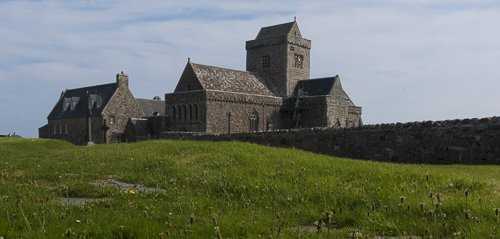Over breakfast, we sailed from Tobermory to Craignure, also on the Isle of Mull, where our coach was waiting to take us across the island to meet the ferry for Iona. The inimitable Dr. Johnson referenced Iona in his classic account of a journey taken in these waters in 1773, A Journey to the Western Islands of Scotland, in which he makes the classic case for travel in any age: “That man is little to be envied, whose patriotism would not gain force upon the plain of Marathon, or whose piety would not grow warm among the ruins of Iona.”
George Macleod, founder of the contemporary Iona Community, famously described the island as “a thin place” where the boundaries between this world and the next come close to transparency; Iona is indeed a very special place and few are impervious to its spiritual atmosphere. It has long been a place of pilgrimage. It the cemetery beside the abbey church lie the mortal remains of High Kings of Scotland, of Norway and Lords of the Isles, that remarkable polity that was an amalgam of the Gaelic and Norse worlds of northern Britain in the Middle Ages. Its renown derived from the fact that Iona was where Columba established his monastic community in A.D. 563 bringing Celtic Christianity from its western redoubt in Ireland where it flourished in the sixth century as the light of the Christian faith was extinguished in continental Europe following the fall of Rome. From Iona the faith spread to the Pictish lands to the east, a route we will follow in the coming days, and then on to the Anglo-Saxon kingdom of Northumbria to the south. It was on Iona that the Book of Kells was produced, one of the glories of early mediaeval western art.
The ecclesiastical buildings that enthrall visitors to the island today all the mediaeval a post-date the Celtic Christian period, the ruins of an early 13th century Augustinian Abbey constructed of pink granite from the neighboring island of Mull, an early Romanesque chapel and the restored the Benedictine Abbey, the latter the base of the contemporary Iona Community. Founded in the 1930s by the redoubtable George Macleod, then a priest with the disadvantaged community of Govan in Glasgow as his parish, his vision was to restore the abbey so that the island would become an ecumenical centre of renewal for the Christian churches of these islands. In the 1930s this seemed an unlikely project but it has succeeded gloriously.
After a wholesome lunch at the aptly-named St Columba hotel we crossed back over to Mull and visited Duart Castle, a baronial pile that is the ancestral seat of the Maclean clan. From banqueting room to dungeon, the latter with gruesome sound effects, we savored the mediaeval atmosphere before returning to the ship. During dinner we sailed for the picturesque harbor of Oban on the Scottish mainland, a lively ferry port and railway terminus famed for its seafood restaurants.
After dinner, a walk to McCaig’s Folly overlooking the town was offered while others watched a superb BBC documentary on the natural history of Mull, an island famed for golden and white-tailed eagles.









